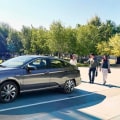The electric vehicle revolution is here, and electric buses and vans are leading the charge. With governments around the world investing in electric vehicle infrastructure, now is the time to understand the differences between electric buses and vans and what they have to offer. From reducing emissions to providing a more cost-effective transportation option, electric buses and vans have many advantages. In this article, we explore the benefits of electric buses and vans, how they compare to traditional vehicles, and what types of electric vehicles are available. Electric buses and vans are becoming an increasingly popular option for transportation due to their cost-effectiveness and eco-friendly nature. They offer a number of advantages over traditional petrol or diesel vehicles, such as lower running costs, reduced emissions, and quieter operation.
It is important to consider a number of factors when selecting the best electric bus or van for your needs. The first step is to consider the size of the vehicle. Electric buses and vans come in a variety of sizes, from small passenger vans to large coaches. Depending on the size of your group or the amount of cargo you need to transport, you will need to select an appropriately sized vehicle.
The next factor to consider is the battery range of the vehicle. Most electric buses and vans have a range of around 100 miles on a single charge, but some vehicles offer longer ranges. It is important to ensure that the vehicle you choose has enough range to complete your journey.
Charging times
are also an important factor to consider.Most electric buses and vans will take around 8 hours to charge from empty to full, but some vehicles can take up to 12 hours. You should make sure that the charging time of the vehicle is suitable for your needs. Cost-effectiveness is another important factor when selecting an electric bus or van. Electric buses and vans typically require less maintenance than traditional petrol or diesel vehicles, meaning that they can be more cost-effective in the long run.
Additionally, electric buses and vans can be cheaper to operate due to their lower fuel costs. Finally, it is important to consider other features when selecting an electric bus or van. Many electric buses and vans come with additional features such as wheelchair accessibility, air conditioning, and USB ports for charging devices. It is important to make sure that the vehicle you select meets all of your needs and has all of the features you require. In summary, electric buses and vans offer a number of advantages over traditional petrol or diesel vehicles, such as lower running costs, reduced emissions, and quieter operation.
When selecting an electric bus or van it is important to consider factors such as size, battery range, charging times, cost-effectiveness, and additional features.
Advantages of Electric Buses & Vans
Electric buses and vans offer a number of advantages over traditional petrol or diesel vehicles. Firstly, electric buses and vans are significantly cheaper to run, as they require less fuel and therefore have lower running costs. Furthermore, electric buses and vans produce fewer emissions than petrol or diesel vehicles, meaning they are more environmentally friendly. Finally, electric buses and vans are much quieter than traditional vehicles, which is beneficial for both drivers and passengers alike. In addition to the cost savings and environmental benefits, electric buses and vans also provide improved performance.Electric vehicles have higher torque than petrol or diesel cars, meaning they can accelerate faster. This can be especially beneficial for public transport, as it can help reduce journey times. Additionally, electric buses and vans require less maintenance than traditional vehicles, which can help keep repair costs to a minimum. Overall, electric buses and vans offer a number of advantages over traditional petrol or diesel vehicles. These include lower running costs, reduced emissions, quieter operation, improved performance, and less maintenance.
As such, electric buses and vans are becoming increasingly popular as an eco-friendly and cost-effective alternative to traditional vehicles.
How to Choose an Electric Bus or Van
When choosing an electric bus or van for your needs, it is important to consider the size of the vehicle, its range, and other features. The size of the vehicle should be based on the number of passengers you plan to transport, as well as the type of cargo you will be carrying. For example, larger buses may be necessary for long-distance trips, while smaller vans may be more appropriate for shorter trips. Additionally, be sure to consider the range of the vehicle, as this will determine how far you can travel before needing to recharge.Other features to consider include the amount of storage space available, the number of charging points, and whether it has wheelchair access. Furthermore, you should also check that the vehicle meets all safety regulations and that it has a good level of comfort for passengers. Finally, you should research the availability of charging infrastructure in your area, as this will determine how easy it is to keep your electric bus or van charged. By taking all of these factors into consideration, you can ensure that you select the best electric bus or van for your needs.
Types of Electric Buses & Vans
Electric buses and vans come in a variety of sizes and models.The most common types of electric buses and vans are minibuses, midibuses, full-sized buses, and vans. Each type of vehicle has its own set of features and benefits that should be considered when selecting the best one for your needs.
Minibuses
Minibuses are ideal for short distances and tight spaces. They offer a flexible and cost-effective way to transport small groups of people. They also have a smaller carbon footprint than traditional petrol or diesel vehicles.Minibuses typically have seating for up to 16 passengers, and some models can be modified to accommodate more.
Midibuses
Midibuses are larger than minibuses and provide more space for passengers and cargo. They typically have seating for up to 25 passengers and can be used for medium-length trips. They are also more fuel-efficient than traditional petrol or diesel vehicles, making them an economical option.Full-Sized Buses
Full-sized buses offer the most capacity for passengers and cargo. They typically have seating for up to 40 passengers, making them ideal for long trips or large groups.They are also more fuel-efficient than traditional petrol or diesel vehicles, making them an economical option.
Vans
Vans are smaller than minibuses and midibuses, but they offer the same level of flexibility as larger models. They typically have seating for up to 8 passengers and can be used for short trips or to transport cargo. They are also more fuel-efficient than traditional petrol or diesel vehicles, making them an economical option. In conclusion, electric buses and vans are becoming an increasingly popular option due to their cost-effectiveness and environmental benefits. There are a range of different types and sizes available, so it is important to consider your needs when choosing an electric bus or van.By following the tips outlined in this article, you can find the perfect electric bus or van for you.











Leave Message